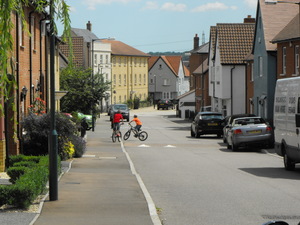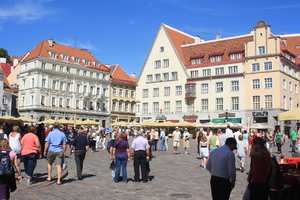The idea that place is important – economically, socially and environmentally – has gathered pace in recent years. Therefore the new book Shaping Places: Urban Planning, Design and Development is welcome. It is written by David Adams and the late Steve Tiesdell, colleagues at the University of Glasgow before Steve’s untimely death in 2011.
The book is about places, not individual buildings. The main message of the book is that “places matter and that shaping places is an essential governance activity” (p.4). The authors argue that physical and environmental aspects of places – the houses, public spaces, streets, green space, waterways and the built heritage from the past – are important in their own right. Indeed this is the main focus of the book. However, the fabric of the place also sets the context and provides the base for economic and social activities.
What makes a successful place?
The book suggests that there are five characteristics of successful places. These are:
• Places meant for people;
• Well-connected and permeable places;
• Places of mixed use and varied density;
• Distinctive places;
• Sustainable, resistant and resilient places.
While these are vague and generalised concepts, the book explains them in detail, using lots of examples and photographs. Thus to create “people-friendly places” you need to put the balance of space in favour of pedestrians rather than cars and slow the speed of vehicles to the point where it no longer threatens other users of the place. Similarly providing flats above shops will enliven a place. Signage, visual identity and street furniture (paving, lampposts, bollard, rubbish bins etc) are also important in creating a positive or negative feeling. Sidewalk cafes or points of interest like fountains will encourage people to feel comfortable and stay awhile.
It is also important to think about accessibility for all, including the elderly, those in push chairs or those with reduced mobility or sight. We also need shelter from the weather, whether from rain, snow or, in some places, hot sunshine. Permeable places are places that are easy to find your way around. This means streets that connect with one another: it is no coincidence that shops are located at intersections where paths cross.
There is no simple formula for achieving “distinctiveness”. Indeed the risk is that standardised approaches make all places into what have been disparagingly called “Clone towns”, all looking the same. Distinctiveness and identity depend fundamentally on the local situation and historical legacy, but can also be achieved on greenfield sites through imaginative design of new developments.

Real estate and investment
A distinctive feature of this book is that it brings together, through the different backgrounds of its authors, a passion for urban design and a sophisticated understanding of how real estate markets operate. As it says, “Real estate markets are central to the way places are created and evolve” (p.39). It also stresses that market forces are not abstract, but rather agencies for human action rooted in rules and conventions. There is not one single “real estate market”, rather a number of sub-markets. Some of these are sectoral – for houses, shops or offices, for example. Others are geographical – for different regions or cities. It is also important to understand the differences between users, investors and developers, all of whom have different aims and priorities.
The book issues the warning that “Planners who ignore real estate value will, at best, fail to exploit what is perhaps the most potent force in determining whether their plans be implemented or not” (p.61). Value does not just depend on location: timing and product are also very important. When acquiring a property such as a house, people also get the place that goes with it – the schools, open space, traffic noise etc. But at the same time the kind of houses in an area influence the kind of place it is. What’s more, tastes change: the recent revelation that young people in the USA now aspire to live in the city rather than the suburbs in which they grew up and to which the previous generations moved, is a prime example of this.
Boom and bust
Any discussion of land and property markets needs to recognise that they have a clear “boom and bust” character. Indeed they are notably more crisis-prone that the economy as a whole. Adams and Tiesdell recognise this and point out how the fluctuations of the market influence power relations. In booms, sites and labour can be hard to find, though investors are likely to be available to back the project. When the downturn comes you can get land and building workers, but the capital to finance a project dries up.
Remember once again there is a geographical dimension to these booms and busts. Even in a general economic recession not everywhere is at the same stage of the cycle. Places where the local economy is weak tend to enter a boom later and experience the downturn sooner. From the public sector point of view, the need is to have developers lined up ready at the start of an upturn, with land, designs and permissions already in place. 
Governance
The risks and complexity of development processes mean that markets alone cannot be relied upon. In addition the shared nature of places means that there is necessarily a governance dimension to place-making and place management. Thus governance is another important theme of the book. Leadership is needed but has to be backed by capacity for effective delivery.
The book sees government actions as neither inherently good or bad: it all depends on how well they do their job. Governments play many roles in the development process. They may be landowners, or occupiers of property. They sometimes operate as a development agency, and also provide essential infrastructure. They also have a regulatory role, e.g. through planning controls over development. Perhaps the greatest challenge for politicians and local government officers is to find ways of building mutual trust between the multiple parties involved in the development process, both from the private sector, the public and other arms and departments of government.
Summary
In short this is a book that many members of the IC network could find very informative. Most of its examples and the context that shapes the authors’ thinking are from the UK. However the underlying ideas are certainly relevant to Scandinavia and the Baltic region. In particular the book is strong on explaining the way the development process operates, and the way that planners and designers’ ambitions need to take account of the criteria that shape investors’ decisions. Shaping Places: Urban Planning, Design and Development by David Adams and Steve Tiesdell (368 pages) is published by Routledge and can be ordered at www.routledge.com/9780415497978. The paperback costs US $53.95.
Pictures
Top: Belmont Street, Aberdeen: The municipal council has been committed for a long time to town centre manaegment and upgrades to streets and public spaces.Supporting street trading by a mix of controls and facilitation can create a lively street scene, benefit traders and attract visitors.
Center: Chancellor Park, Chelmsford, England: Speculative housebuilders began to produce development of this quality and div eersity once the local council used its planning powers to take a firm stand against standard house types and layouts.
Bottom: Tallinn’s Old Town Square, Estonia is now a World Heritage Site, and works as a space where people can meet, shop and enjoy the place.
![]()